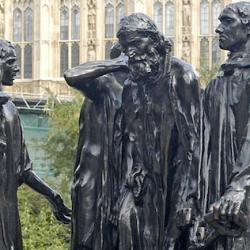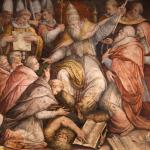Traci Slatton, novelist wife of sculptor Sabin Howard, is ecstatic about sculpture. Her 2011 Art of Life is a passionate, occasionally overwrought, defense of sculpture as the master art, filled with photos of her husband’s stunning classical figures.
She points out the complexity of sculpting. While a painting presents a single angle of vision, determined by the painter, “sculpture shows an infinite number of views, including eight principle views, as a viewer walks around a piece. Each view has to be beautiful, has to be compelling, or the sculpture fails.” This is why “it’s hard to make a sculpture work. It’s even harder to make a great sculpture.”
Da Vinci said that sculpture did not represent luminosity, but Slatton disagrees: “sculpture is all about light; about the play of light and shadow on forms that bulge and drop, about the dazzling interplay of perspectives of light and shadow as the viewer walks around the piece, about the gathering of light on a high point and the dispersion of light in the low point.”
And, despite its apparently static quality, sculpture is “actually in motion, telling a story as the viewer moves. In this respect, it’s like a movie: sculpture bespeaks movement, it shows change and fights stasis. It argues a thesis about our common humanity.”
These qualities give sculpture the power to shake “us loose from our pedestrian daily moorings. It tells us a story and changes our state of being. It alters our state of consciousness. It wakes us up. It stirs us to new insights, new imaginings about what the world is, about what our lives could be, about who we are. It opens up for us a vista of choice and possibility, and it does this through beauty.”
Slatton calls for a new artistic movement that she labels “unitive realism.” The realism is clear enough, and her husband’s work presents spectacular examples of realism’s continuing power. The unitive part is more elusive: “It’s unitive because the artist connects the tradition to the present and to the future; it’s also unitive because it connects viewers to a larger realm of which they are a part, a realm of aesthetics, truth, and spirit. It’s unitive because it joins the artists’ personal human vision with the concrete object of perception. Beauty is the grammar of this movement.”
Art of Life, a beautiful book, is also, Slatton says, “an unapologetic call to beauty.”














